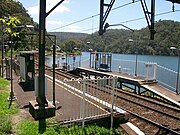Request stop
This article needs additional citations for verification. (May 2010) |
In public transport, a request stop, flag stop, or whistle stop describes a stop or station at which trains or buses stop only on request; that is, only if there are passengers to be picked up or dropped off. In this way, ill-frequented stops can be incorporated into a route without introducing unnecessary delay.
Vehicles may also save fuel by continuing through a station when there is no need to stop.
There may not always be a significant savings on time if there is no one to pick up because vehicles going past a request stop may need to slow down enough to be able to stop if there are passengers waiting. Request stops may also introduce extra travel time variability and increase the need for schedule padding.
Implementations
The methods by which transit vehicles are notified that there are passengers waiting to be picked up at a request stop vary by transit system and by route.
Local transport
Most local, inner-city bus operations operate almost all of their stops as request stops, even if there is almost always a passenger boarding or alighting. To distinguish stops that are served on every trip, these are usually called stations and they are most often at the terminals of a route. Such stops are often also used as timepoints.
In bus transport the term request stop may also be used to refer to a stop on a hail and ride section of a route. In hail and ride operations, there are few or no marked stops and passengers can request the bus be stopped at any point where the driver can safely and reasonably do so.
In some cities, flag stops may refer to any stop that has regular service, but is not signed by the authorities serving it. This is extremely common in some cities, such as Tulsa, Oklahoma, where bus stops are infrequently signed; buses in such systems will stop on request typically after any intersection where it is safe to do so and there is no signed stop within a one-block radius.
Long distance transport
In long distance transport, transit vehicles such as passenger trains or buses operating on motorways, usually operate at higher speeds than local transport. This means that stopping is more troublesome (and more worth avoiding) and that it may be very difficult to see a passenger in time to stop for them. This difference often results in more complicated ways of signalling a stop to the vehicle.
Some services, like Amtrak, require that a ticket be purchased in advance, specifying a specific origin and destination. Since the train's crew know what tickets were sold, they also know where people are coming from and going to, and they simply stop only at those stations required by the tickets. Services that don't have advanced ticketing, or which sell tickets for a range of destinations or travel times, require ways of knowing whether or not someone is waiting at a station or platform. These may range from a passenger speaking to a dispatcher on a phone located at a station to simply pressing a button to activate a signal such as a flashing light somewhere before the station that the driver can see in time to slow down safely.
Ferries
Along some ferry routes in the fjords in Norway, some stops are equipped with a light that embarking passengers must switch on in order for the ferry to include the stop and pick them up. The system is known under the name 'signalanløp'. Similar to Norway, commuter ferries are requested to stop by a semaphore signal. The many islands of the Stockholm archipelago are an example of this.
Gallery
The appearance of request stops varies wildly. Many are clearly signed, but many others rely on local knowledge.
-
Traditional sign of a request stop of the former Czechoslovak national bus operator ČSAD
-
A sign of a request stop ("na znamení") of urban bus line in Prague
-
Wondabyne railway station is a request stop, located north of Sydney.




